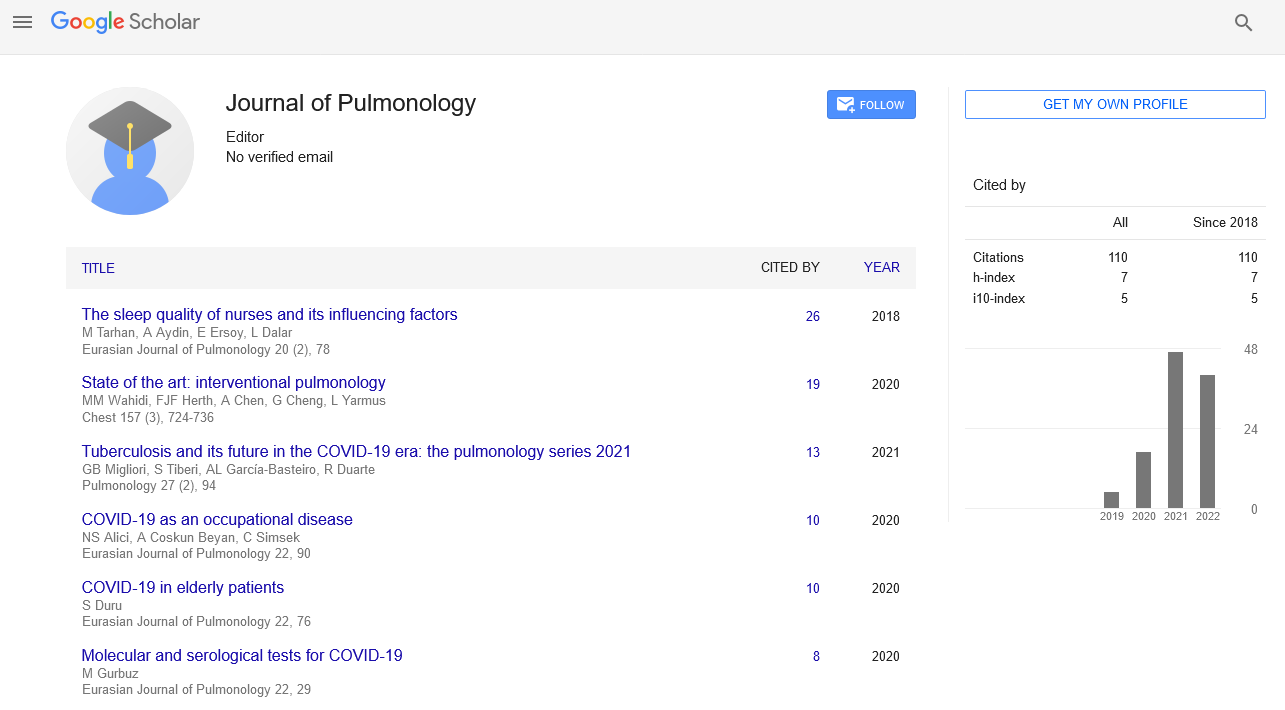Acute pulmonary embolism in an Asian population: clinical characteristics
Received: 03-Jan-2022, Manuscript No. puljp-22-5806 ; Editor assigned: 06-Jan-2022, Pre QC No. puljp-22-5806 (PQ); Accepted Date: Jan 26, 2022; Reviewed: 18-Jan-2022 QC No. puljp-22-5806 (Q); Revised: 24-Jan-2022, Manuscript No. puljp-22-5806 (R); Published: 30-Jan-2022
Citation: Shree. S Acute pulmonary embolism in Asian population: clinical characterstics J. Pulmonol. 6(1):6-7.
This open-access article is distributed under the terms of the Creative Commons Attribution Non-Commercial License (CC BY-NC) (http://creativecommons.org/licenses/by-nc/4.0/), which permits reuse, distribution and reproduction of the article, provided that the original work is properly cited and the reuse is restricted to noncommercial purposes. For commercial reuse, contact reprints@pulsus.com
Abstract
The prevalence of Acute Pulmonary Embolism (APE), a frequent disease, is rising globally. However, there is still a lack of information regarding the clinical traits, risk factors, and clinical outcomes of APE in the Asian population, particularly in the Thai community. Finding the clinical traits, risk factors, and clinical outcomes of APE in the Asian population was the study's primary goal.
Keywords
Acute pulmonary embolism; Clinical characteristics; Risk factor; mortality; Asian population
Introduction
Aacute Pulmonary Embolism (APE) is a frequent illness that is becoming more prevalent in Western nations and it has a significant fatality rate if it is not treated properly. The lower incidence of APE in Asian nations compared to Western nations may be due to a lack of clinical suspicion and insufficient healthcare
Because the clinical manifestations, including symptoms, signs, and investigations, were ambiguous and ranged from asymptomatic (incidental PE) to abrupt respiratory failure and/or shock (high-risk PE), APE is characterized as "the great masquerader" [8]. Numerous clinical risk factors, including patient factors like older age, comorbidities, thrombophilia, obesity, cancers, inflammatory bowel diseases, and history of venous thromboembolism, as well as situation factors like surgery, trauma, and immobilization, are linked to venous thromboembolism.
The diagnosis will probably be enhanced by the growing accessibility of emerging imaging modalities. Despite improvements in diagnostic techniques, APE diagnosis delays are still frequent and hurt clinical outcomes the management of APE requires a high index of clinical suspicion, proper diagnostic testing, clinical severity assessment, and suitable therapy. However, more research is still needed on APE's clinical traits, risk factors, and clinical outcomes in the Asian population, particularly in Thailand. To better understand APE in the Asian population, this study aims to identify the clinical traits, risk factors, and clinical outcomes of patients with APE in our center.
Method
By the pertinent international ethical standards, rules, and laws, including the Declaration of Helsinki, this cross-sectional study was approved by the Research Ethics Committee of the Faculty of Medicine at Chiang Mai University (Institutional Review Board (IRB) approval number: MED-2564-08294, date of approval; 29 July 2021). Because the data were examined retroactively from the medical records, the Research Ethics Committee permitted a waiver of informed consent
All patients with an ICD-10 coding of I26.0 (pulmonary embolism with acute cor pulmonale) or I26.9 (pulmonary embolism without acute cor pulmonale) who were 15 years of age or older at Chiang Mai University Hospital in Chiang Mai, Thailand between 2011 and 2020 were recruited. Only patients whose diagnoses of APE were verified by assessment of their medical records moved forward with data analysis.
Radiologists confirmed the diagnosis of APE after Computed Tomographic Pulmonary Angiography (CTPA) or CT chest with contrast revealed a thrombus in the pulmonary arteries and its branches.
According to the 2019 European Society of Cardiology (ESC) guideline, patients with APE were categorized as having high-risk PE or having intermediate-risk or low-risk PE depending on whether there was evidence of hemodynamic instability (defined as Systolic Blood Pressure [SBP] 90 mmHg for>15 min, drop in SBP of 40 mmHg or more from baseline, or needing hemodynamic support)The risk variables that predispose were found.
Results
A total of 1560 patient data from the ICD-10 coding diagnostic were gathered between 2011 and 2020, and the number of APE patients tended to rise with time. Eight hundred and sixty-four patient records were eliminated because they involved patients who were less than 15 years old, were not Asian, had multiple cases, and lacked CT confirmation of their diagnoses. There were 696 patients evaluated, with a mean age of 15.7 years (range: 15–98) and a male-to-female ratio of 41.1%. The most prevalent comorbidity, hypertension, was present in 388 individuals (or 55.7%), of whom. In 245 patients (35.3%), Deep Vein Thrombosis (DVT) was identified in addition to APE. Clinically suspected APE was present in 468 patients (67.2%), while 228 patients were unrelated.
Risks factor
In 560 patients (80.5%), risk factors for APE were discovered. The most frequent risk factor was active malignancy (388 patients, or 55.7% of cases), followed by immobility (211 patients, or 30.4%), surgery or trauma requiring endotracheal intubation or epidural anesthesia within four weeks (141 patients, or 20.3% of cases), and immobility. Cancer-associated APE frequently contained cases of colorectal, lung, and cholangiocarcinoma cancer.Conclusion
The Asian population had a high prevalence of APE. Clinical features, mortality trends, and prevalence trends were comparable to those of Western nations. The most frequent risk factors were immobility and active malignancy, particularly lung cancer and cholangiocarcinoma. Although the number of cases was on the rise, deaths from PE were on the fall. High mortality was linked to high-risk and intermediate-high-risk PE. To improve results, risk categorization and quick management are necessary.





